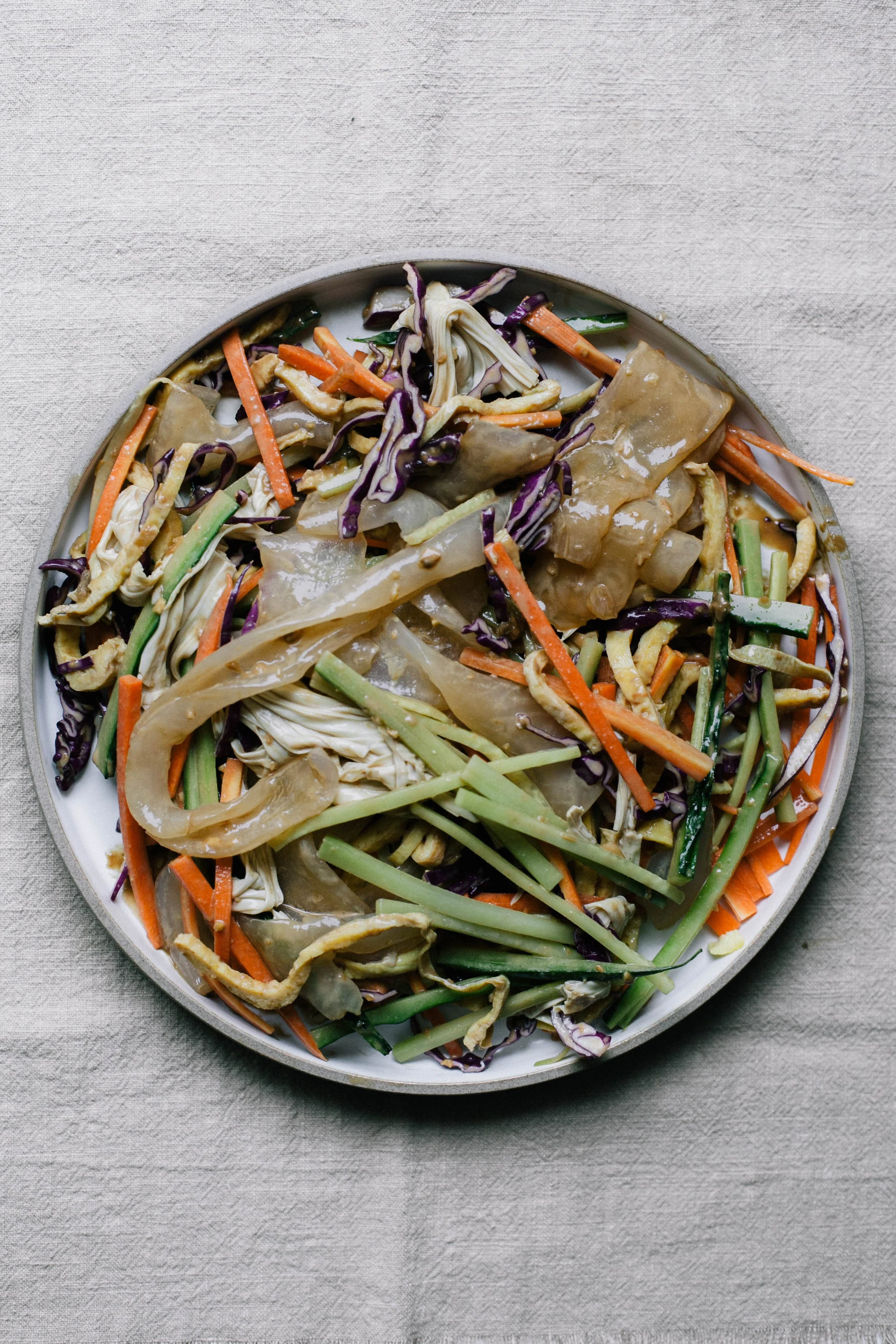
Dongbei ‘Da Lapi’ Noodles
东北大拉皮
English: Dongbei ‘Da Lapi’ Noodles
Chinese: 东北大拉皮
Pinyin: dongbei da lapi
Literal: Dongbei Big Pulled Skin Noodles
While Shaanxi's Cold-Skin Noodles (liang pi | 凉皮) are known throughout China, their Northeast cousin, Dongbei Da Lapi (东北大拉皮 or "Big Pulled Skin Noodle”), remains one of Northern China's little culinary secrets. This vibrant summer dish shares the refreshing appeal of its more famous relative but boasts a character entirely its own.
At the heart of Da Lapi are the thick, transparent mung bean starch noodles (or sometimes potato starch). These aren't ordinary noodles—they have a fascinating otherworldly texture: slippery, chewy, and sticky, creating an experience that's impossible to forget. When tossed with the dressing and served chilled with crunchy veg, we end up with China’s version of a summer salad.
The dressing is a combination of classic Northern ingredients - rich Chinese sesame paste forms the foundation, vinegar adds brightness, soy sauce gives it depth, and sesame oil brings a nutty complexity. Sweetened with a touch of sugar and awakened with fresh garlic, this sauce clings to every strand of those translucent noodles, creating a smooth creaminess to each bite.
What truly sets Da Lapi apart is its presentation—a bright celebration of colour and texture that stands apart from Northern China's usual simple and rustic dishes. Traditionally arranged like a sunburst, the dish features a central nest of clear noodles surrounded by a colourful array of julienned vegetables and tofu, creating a spectacular table decoration.
The beauty of Da Lapi lies in its adaptability. While cucumber and carrot provide the classic crunch, the dish welcomes whatever the season offers: the earthy complexity of wood ear mushrooms, the peppery bite of radish, the sweet juiciness of tomatoes, or the protein of a sliced egg omelet. There are few rules to this dish - the chef adding whatever is coming out of the soil that day.
Perhaps most remarkable is Da Lapi's celebration of raw vegetables—a rarity in traditional Chinese cuisine. In a culinary tradition where cooking techniques typically transformed raw ingredients for both flavour and safety, this dish is an exception.
Serves 4
Ingredients
150g fresh wood ear mushrooms (or 50g dried)
2 cloves garlic, finely minced
1-2 fresh red chilies, thinly sliced
2 tablespoon Chinese black vinegar
1 tablespoon light soy sauce
1 teaspoon sugar
½ teaspoon salt (adjust to taste)
1 tablespoon sesame oil
½ bunch of fresh coriander/cilantro - roughly chopped
1 teaspoon toasted sesame seeds
Ingredients
For the Noodles
200g mung-bean-starch noodles (大拉皮 or liangpi)
For the Vegetables (choose 4)
1 small cucumber, julienned
1 medium carrot, julienned
1/4 cup wood ear mushrooms, cooked and sliced
A handful of fresh cilantro, chopped
1/4 red cabbage, thinly sliced
100g tofu skin (豆腐皮)
1 long red radish, julienned
Egg omelette, thinly sliced
For the Sauce
2 tablespoons soy sauce
1 tablespoon black vinegar
1 tablespoon sesame paste (Chinese 麻酱)
1 teaspoon mustard powder mixed with water
1 teaspoon sugar
2 garlic cloves, finely chopped
1 tablespoon chili oil
1 teaspoon sesame oil
For Garnish
1 tablespoon roasted peanuts or sesame seeds
Method
Note: If you cannot find traditional mung-bean-starch noodles, you can substitute potato starch noodles or liang pi noodles.
Cook the mung bean starch noodles according to package instructions—typically by soaking in hot water until soft and chewy. Drain thoroughly and rinse under cold water to stop the cooking process and remove excess starch. Set aside.
Prepare the vegetables. Julienne or slice all your chosen vegetables. Keep them separate for the final presentation.
Prepare the specialty ingredients:
For tofu skin: Blanch in boiling water for 1 minute. Drain, pat dry, and slice into thin strips.
For egg omelette: Whisk 3 eggs with a pinch of salt. Heat a frying pan over medium heat with a drizzle of oil. Pour in the egg mixture and cook for 2-3 minutes on each side until set. Remove from heat, roll the omelette tightly (like a cigar), and slice thinly into strands.
Make the sauce. In a bowl, whisk together soy sauce, black vinegar, sesame paste, mustard paste, sugar, garlic, chilli oil, and sesame oil. Taste and adjust seasoning as needed. The perfect balance includes savoury notes from the soy sauce, tanginess from the vinegar, nuttiness from the sesame components, and a gentle heat from the mustard and chilli oil.
Assemble the dish. Arrange the vegetables, tofu skin, and/or egg strands in a circular pattern around the edge of a large plate, creating a colourful border. Place the chilled noodles in the centre to complete the sunburst appearance.
Sprinkle the roasted peanuts or sesame seeds over the dish. Bring the plate to the table with the dressing served separately in a small pitcher or bowl.
At the table, pour the sesame dressing over the assembled dish. For easier eating, transfer everything to a large bowl and toss thoroughly to ensure all ingredients are evenly coated with the dressing before serving.



